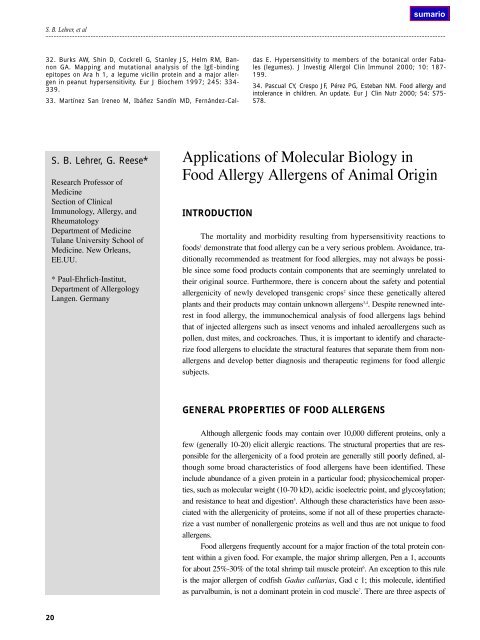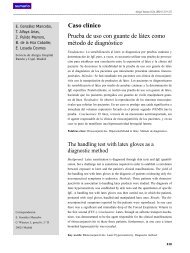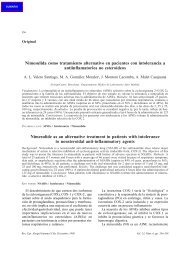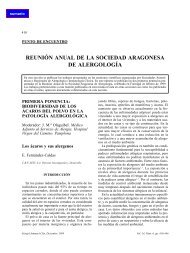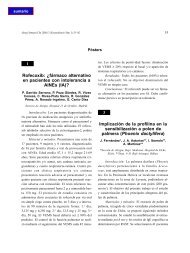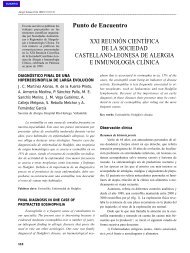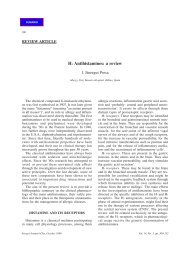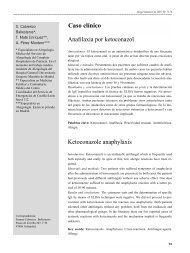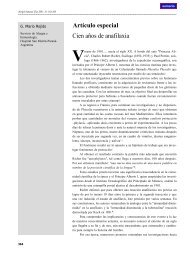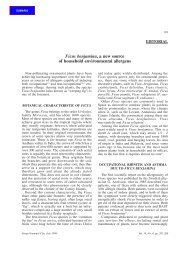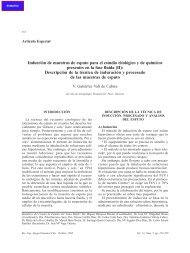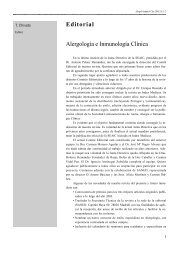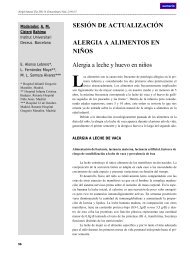Aplicación de la biología molecular en alergia a alimentos
Aplicación de la biología molecular en alergia a alimentos
Aplicación de la biología molecular en alergia a alimentos
Create successful ePaper yourself
Turn your PDF publications into a flip-book with our unique Google optimized e-Paper software.
S. B. Lehrer, et al<br />
32. Burks AW, Shin D, Cockrell G, Stanley JS, Helm RM, Bannon<br />
GA. Mapping and mutational analysis of the IgE-binding<br />
epitopes on Ara h 1, a legume vicilin protein and a major allerg<strong>en</strong><br />
in peanut hypers<strong>en</strong>sitivity. Eur J Biochem 1997; 245: 334-<br />
339.<br />
33. Martínez San Ir<strong>en</strong>eo M, Ibáñez Sandín MD, Fernán<strong>de</strong>z-Cal-<br />
20<br />
S. B. Lehrer, G. Reese*<br />
Research Professor of<br />
Medicine<br />
Section of Clinical<br />
Immunology, Allergy, and<br />
Rheumatology<br />
Departm<strong>en</strong>t of Medicine<br />
Tu<strong>la</strong>ne University School of<br />
Medicine. New Orleans,<br />
EE.UU.<br />
* Paul-Ehrlich-Institut,<br />
Departm<strong>en</strong>t of Allergology<br />
Lang<strong>en</strong>. Germany<br />
Applications of Molecu<strong>la</strong>r Biology in<br />
Food Allergy Allerg<strong>en</strong>s of Animal Origin<br />
INTRODUCTION<br />
das E. Hypers<strong>en</strong>sitivity to members of the botanical or<strong>de</strong>r Fabales<br />
(legumes). J Investig Allergol Clin Immunol 2000; 10: 187-<br />
199.<br />
34. Pascual CY, Crespo JF, Pérez PG, Esteban NM. Food allergy and<br />
intolerance in childr<strong>en</strong>. An update. Eur J Clin Nutr 2000; 54: S75-<br />
S78.<br />
The mortality and morbidity resulting from hypers<strong>en</strong>sitivity reactions to<br />
foods 1 <strong>de</strong>monstrate that food allergy can be a very serious problem. Avoidance, traditionally<br />
recomm<strong>en</strong><strong>de</strong>d as treatm<strong>en</strong>t for food allergies, may not always be possible<br />
since some food products contain compon<strong>en</strong>ts that are seemingly unre<strong>la</strong>ted to<br />
their original source. Furthermore, there is concern about the safety and pot<strong>en</strong>tial<br />
allerg<strong>en</strong>icity of newly <strong>de</strong>veloped transg<strong>en</strong>ic crops 2 since these g<strong>en</strong>etically altered<br />
p<strong>la</strong>nts and their products may contain unknown allerg<strong>en</strong>s 3,4 . Despite r<strong>en</strong>ewned interest<br />
in food allergy, the immunochemical analysis of food allerg<strong>en</strong>s <strong>la</strong>gs behind<br />
that of injected allerg<strong>en</strong>s such as insect v<strong>en</strong>oms and inhaled aeroallerg<strong>en</strong>s such as<br />
poll<strong>en</strong>, dust mites, and cockroaches. Thus, it is important to i<strong>de</strong>ntify and characterize<br />
food allerg<strong>en</strong>s to elucidate the structural features that separate them from nonallerg<strong>en</strong>s<br />
and <strong>de</strong>velop better diagnosis and therapeutic regim<strong>en</strong>s for food allergic<br />
subjects.<br />
GENERAL PROPERTIES OF FOOD ALLERGENS<br />
Although allerg<strong>en</strong>ic foods may contain over 10,000 differ<strong>en</strong>t proteins, only a<br />
few (g<strong>en</strong>erally 10-20) elicit allergic reactions. The structural properties that are responsible<br />
for the allerg<strong>en</strong>icity of a food protein are g<strong>en</strong>erally still poorly <strong>de</strong>fined, although<br />
some broad characteristics of food allerg<strong>en</strong>s have be<strong>en</strong> i<strong>de</strong>ntified. These<br />
inclu<strong>de</strong> abundance of a giv<strong>en</strong> protein in a particu<strong>la</strong>r food; physicochemical properties,<br />
such as molecu<strong>la</strong>r weight (10-70 kD), acidic isoelectric point, and glycosy<strong>la</strong>tion;<br />
and resistance to heat and digestion 5 . Although these characteristics have be<strong>en</strong> associated<br />
with the allerg<strong>en</strong>icity of proteins, some if not all of these properties characterize<br />
a vast number of nonallerg<strong>en</strong>ic proteins as well and thus are not unique to food<br />
allerg<strong>en</strong>s.<br />
Food allerg<strong>en</strong>s frequ<strong>en</strong>tly account for a major fraction of the total protein cont<strong>en</strong>t<br />
within a giv<strong>en</strong> food. For example, the major shrimp allerg<strong>en</strong>, P<strong>en</strong> a 1, accounts<br />
for about 25%-30% of the total shrimp tail muscle protein 6 . An exception to this rule<br />
is the major allerg<strong>en</strong> of codfish Gadus cal<strong>la</strong>rias, Gad c 1; this molecule, i<strong>de</strong>ntified<br />
as parvalbumin, is not a dominant protein in cod muscle 7 . There are three aspects of


